
The postal and philatelic history of Canada concerns postage of the territories which have formed Canada. Before Canadian confederation, the colonies of British Columbia and Vancouver Island, Prince Edward Island, Nova Scotia, New Brunswick and Newfoundland issued stamps in their own names. The postal history falls into four major periods: French control (1604–1763), British control (1763–1841), colonial government control (1841–1867), and Canada, since 1867.

The Penny Red was a British postage stamp, issued in 1841. It succeeded the Penny Black and continued as the main type of postage stamp in the United Kingdom of Great Britain and Ireland until 1879, with only minor changes to the design during that time. The colour was changed from black to red because of difficulty in seeing a cancellation mark on the Penny Black; a black cancellation mark was readily visible on a Penny Red.
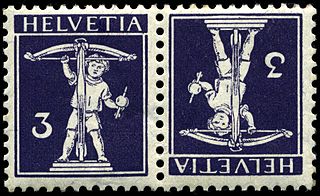
This is a survey of the postage stamps and postal history of Switzerland.

Postage stamps and postal history of Great Britain surveys postal history from the United Kingdom and the postage stamps issued by that country and its various historical territories until the present day.
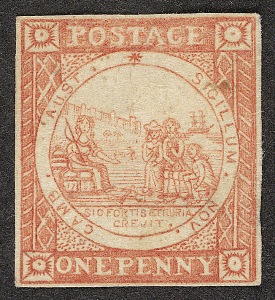
This is a survey of the postage stamps and postal history of New South Wales, a former British colony now part of Australia.

The postage and revenue stamps of the United Kingdom issued in 1887 are known as the "Jubilee" issue because they were issued during the year of the Golden Jubilee of Queen Victoria to the throne in 1837. They continued in use throughout the remainder of Victoria's reign, and many of the designs were reused in the stamps of Edward VII. The Jubilee issue includes the first British stamps to be printed in two colours.
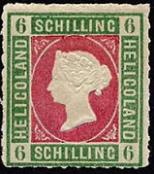
During the period when Heligoland was a British possession, about 20 postage stamps were issued between 1867 and 1890. There were up to eight printings of a single denomination and also a large volume of reprints which are known as the Berlin, Leipzig and Hamburg Reprints, respectively. The Berlin reprints are sometimes better quality than the originals. The reprints were done between 1875 and 1895. Consequently, many "old" collections contain reprints rather than originals. Some believe there were seven million reprints as compared to the known 1½ million originals, of which perhaps half were sold through the post office and the remainder sold to dealers when withdrawn from use. A few printings were never postally sold but nevertheless found their way into the hands of dealers. The stamps were printed by the Prussian State Printing Office in Berlin. They were denominated in the Hamburg Schilling until 1875, when both German Reich and British values appeared on each stamp issue. All are embossed with a silhouette of Queen Victoria excepting the four highest values which represent Heligoland escutcheons.

The Chalon Head is the name of a number of postage stamp series whose illustration was inspired by a portrait of Queen Victoria by Alfred Edward Chalon (1780–1860).

The Castle series or Castle High Value series are two definitive stamp series issued in the United Kingdom during Queen Elizabeth II's reign. The common aspects of the two series are the four chosen castles, one for each country of the United Kingdom.

Mauritius, a small island in the southwest Indian Ocean, is important to the world of philately for a number of reasons. Its first two postage stamps issued in 1847, called the "Post Office" stamps, are of legendary rarity and value. They were the first stamps issued in any part of the British Empire outside of Great Britain. The unique cover bearing both “Post Office” stamps has been called "la pièce de résistance de toute la philatélie" or "the greatest item in all philately". The cover was sold at auction, in Zurich, on 3 November 1993, for 5.75 million Swiss francs, the equivalent of about $4 million – the highest price ever paid for a single philatelic item up to that time. In addition, Mauritius is well known for the subsequent locally produced issues known as "primitives," also prized by collectors.

Plating refers to the reconstruction of a pane or "sheet" of postage stamps printed from a single plate by using individual stamps and overlapping strips and blocks of stamps. Likewise, if a sheet 10 or 20 postal cards is typeset, the variations of the letters or design elements may allow reconstruction or plating of the sheets based on these differences.
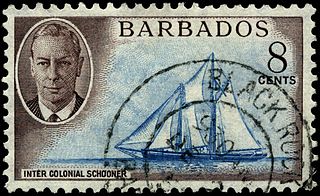
This is a survey of the postage stamps and postal history of Barbados.

This is a survey of the postage stamps and postal history of Cape of Good Hope.

St. Lucia a former British dependency in the Windward Islands began using stamps in 1860. It achieved Associated Statehood on 1 March 1967. In 1979, it gained independence.

This is a survey of the postage stamps and postal history of South Australia, a former British colony that is now part of Australia.

Revenue stamps of the United Kingdom refer to the various revenue or fiscal stamps, whether adhesive, directly embossed or otherwise, which were issued by and used in the Kingdom of England, the Kingdom of Great Britain, the United Kingdom of Great Britain and Ireland and the United Kingdom of Great Britain and Northern Ireland, from the late 17th century to the present day.
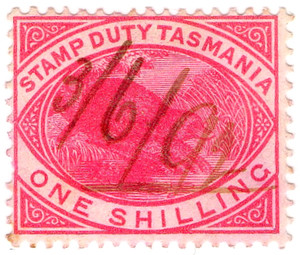
The Australian state of Tasmania issued adhesive revenue stamps from 1863 to 1998, although impressed stamps had appeared briefly in the 1820s. There were general revenue and stamp duty issues, as well as a number of specific issues for various taxes.

The island of Cyprus first issued revenue stamps in 1878 and continues to do so to this day. The Turkish Republic of Northern Cyprus also issues its own revenue stamps.
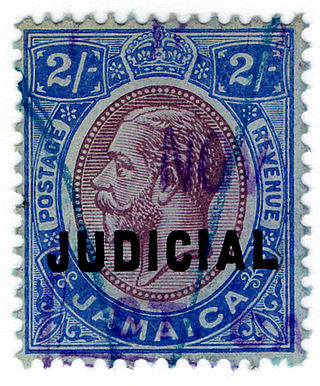
Revenue stamps of Jamaica were first issued in 1855. There were various types of fiscal stamps for different taxes.

Canada 12d black or The Black Empress of Canada is the rarest Canadian postage stamp, issued in 1851. The 12-pence stamp shows the portrait of Queen Victoria and is the third stamp issued by the province.



















